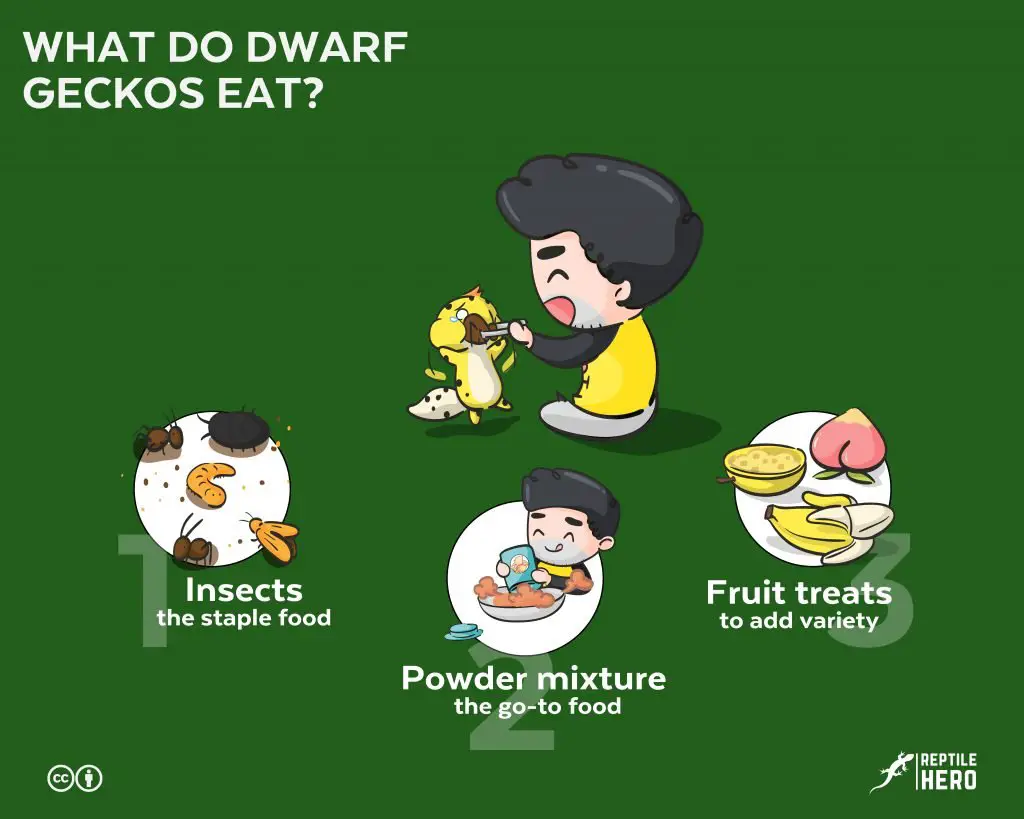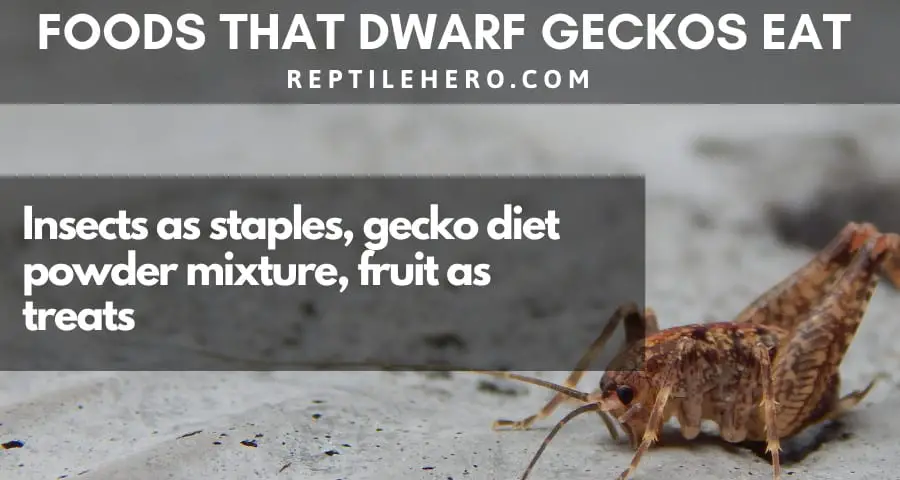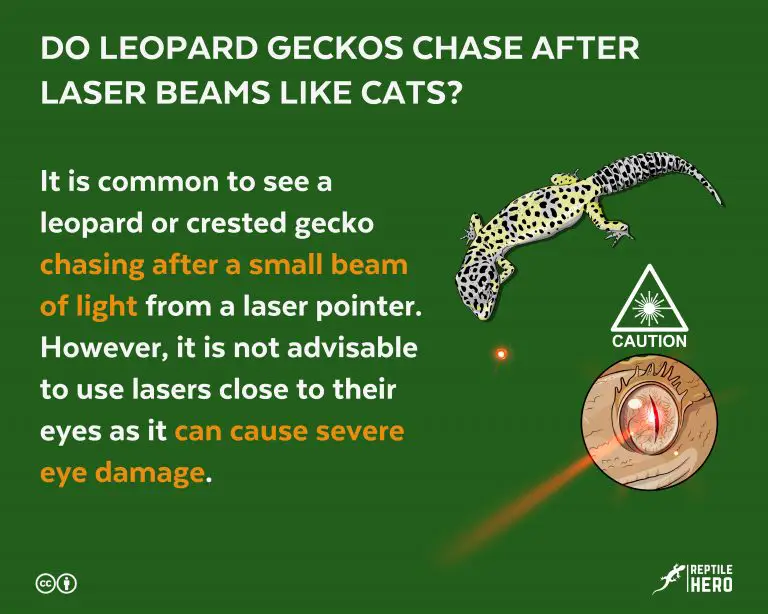What Do Dwarf Geckos Eat? [With Examples + 6 Things To Remember]
When visiting reptile expos, one of the various gecko species you might encounter is dwarf geckos. Their atypical size and more exotic look might attract you to bring one home! But before that, do you have any idea what they eat?
Dwarf geckos are small insectivorous lizard species that primarily prey on microarthropods as a staple food. In captivity, they can be fed with gecko diet powder mixture as an alternate food. Also, they infrequently eat fruit as treats.

Dwarf geckos are unusually tiny, and so are their foods! Tag along to get to know more about what dwarf geckos eat.
Dwarf Geckos: Food and Nutrition
Like most geckos, dwarf geckos are carnivores—specifically insectivores. Thus, their diet should mainly consist of insects, even in captivity.
Despite this, some owners find an unusual benefit of incorporating fruit mixtures as treats when feeding these small lizards.
| Nutrient | Percentage |
|---|---|
| Fat | 25 – 60% |
| Protein | 30 – 60% |
| Carbohydrates | minimal |
| Fiber | negligible |
What are Examples of Dwarf Gecko Food?
Dwarf gecko food can be grouped into 1) feeder insects, 2) powder mixture, and 3) fruit treats.
As insect-eating reptiles, dwarf geckos have a short and simple digestive tract. So, a massive chunk of their diet must comprise crickets, among other feeder insects, alternating them once in a while.
#1. Insects: The Staple Food
In captivity, dwarf geckos can be fed with the typical feeder insects sold in pet supplies stores. These feeders make up their staple food.
A large list of insects that dwarf geckos can eat includes the following:
- Aphids (Acyrthosiphon pisum)
- Bean Beetles (Callosobruchus maculatus)
- Black Soldier Fly Larvae (ReptiWorms)
- Dubia Roaches (Blaptica dubia)
- Firebrats (Thermobia domestica)
- Fruit Flies (Drosophila melanogaster or D. hydei)
- House Flies (Musca domestica)
- Hornworms (Manduca sexta)
- Mealworms (Tenebrio molitor)
- Pinhead Crickets (Gryllodes sigillatus)
- Rice Flour Beetle (Tribolium confusum)
- Silkworms (Bombyx mori)
- Springtails (Folsomia candida)
- Waxworms (Galleria mellonella)
- Woodlice (Trichorhina tomentosa)
- Meadow Plankton
- Field Sweepings
- Isopods
While the list might look like it covers a variety of small arthropods, this is actually nothing in contrast to what these little lizards feed on in the wild. So, do not limit yourself to this list. Explore other possible feeders you can find as every chance to diversify their food must be taken!
Warning!
Do not feed wild-caught insects (may carry parasites) and bio-luminescent bugs (contain toxic chemicals).
#2. Gecko Diet Powder Mixture: The Go-To Food
Owners of dwarf geckos can offer a gecko diet powder mixture as a temporary food.
There are instances where you ran out of feeder insects, and you cannot buy just yet. During these times, a gecko diet powder mixture can save your day. Temporarily, you can feed it to your dwarf gecko until the insects arrive. Otherwise, you can also incorporate it into your gecko’s diet to add a little variety.
Unfortunately, dwarf geckos do not have their own commercially formulated powder mixture. As a result, you can use other formulas like those for crested geckos from popular brands.
Warning!
Do not feed human baby food to your dwarf gecko, even though many owners frequently do this. Baby food is an inappropriate food that does not contain the proper nutrients that dwarf geckos need.
#3. Fruit Treats: To Add Variety
Fruits are fed to dwarf geckos as rare treats for an occasional variation in their diet.
As you have already known, dwarf geckos are insectivores. So, food from plants is not a part of their natural diet. Strangely, a lot of owners have practiced feeding their pets with fruits and yogurt as infrequent treats.
The usual fruits are banana, passion fruit, and peach in pulp, puree, or smoothie given at most once every two weeks.
Warning!
Knowing that plant-based foods are unnatural for dwarf geckos, you have to stop at once when you notice adverse effects on their health. In addition, you should avoid giving fruits that belong to any of the following:
- Fruits rich in Vitamin C. Many owners have noted diarrhea after their geckos have consumed oranges, lemons, pineapples, and the like.
- Fruits rich in Oxalic Acid. Studies have revealed that these fruits can reduce available calcium in the gecko’s body, causing hypocalcemia [1].
- Fruits rich in Persin. Persin is a fungicidal toxin to cats and dogs. Likewise, fruits rich in this chemical can be lethal to dwarf geckos [2].

The Main Hurdle: 6 Things to Keep in Mind
Due to their small size, dwarf geckos might lack the diversity of feeder insects available in the market. Indeed, not many feeders are minuscule enough that they could feed on.
Because of this, most owners solely rely on small crickets or micro mealworms, which can massively deteriorate the gecko’s health.
To guide you with this dilemma, here are six things you have to keep in mind when feeding dwarf geckos.
#1. Size of the Insect
Dwarf geckos should be given feeder insects measuring between 1/8 to 1/4 inch, depending on their age.
However, if you forget the numbers, you can never forget the rule of thumb:
“Feed only with feeder insects that are not broader or wider than the distance between their two eyes.”
| Age of Dwarf Gecko | Size of Feeder Insect |
|---|---|
| Babies and Juveniles | about 1/8 inch |
| Adults | about 1/4 inch |
Honestly, even though you recall the excellent rule of thumb or the actual numbers, it is still a big challenge you should prepare as a dwarf gecko parent. Finding such minute insects to feed them can get arduous, knowing that these geckos do get too small—rarely exceeding 4 inches.
#2. State of the Insect
An excellent dwarf gecko staple feeder insect is a live insect, not the freeze-dried or frozen ones.
Apart from the better nutrition profile, the main advantage of feeding live feeders is the stimulation to forage for food. As the insect crawls, jiggles, and hops, these movements can trigger the gecko’s innate hunting instincts.
As a result, aside from the challenge posed by the feeder insect’s size, you might have to deal with another one—handling live insects. Nonetheless, as a responsible reptile parent, following the advice of feeding live feeders reduces the chance of eating food with decreased nutrients from the freeze-dried and frozen ones [3].
#3. Number of Insects
The number of feeder insects should be appropriate to the age of the dwarf gecko.
While there are guidelines on how many insects to feed your dwarf gecko, it is still best to observe your pet within its first few feedings.
So, you basically have to count the number of insects you place in the enclosure and count the number of uneaten insects. Then, get the number of insects your gecko has eaten by subtracting the two values.
| Age of Dwarf Gecko | Number of Feeder Insect |
|---|---|
| Babies | at least 2 |
| Juveniles | around 4 |
| Adults | at most 8 |
Dwarf geckos are known to be big eaters with aggressive appetites. This makes it crucial for you to determine the average number of insects to avoid overfeeding. Hence, you should give only as many feeders as your reptile can eat at once.
#4. Frequency of Feeding
The frequency of feeding dwarf geckos differs primarily with age.
Just like how many insects you can and should feed your dwarf gecko, the feeding frequency also varies significantly with age.
| Age of Dwarf Gecko | Frequency of Feeding |
|---|---|
| Babies | every day |
| Juveniles | every two days |
| Adults | every three days |
Even though it is a good habit to follow what you can find on reliable sources, you are still better off using such information with a grain of salt.
One way to do this is to utilize it as a starting point on how you start your feeding journey. From then on, you adjust the frequency accordingly and as needed by your reptile. After all, every gecko is distinct from one another; and the information online can only serve as a basis.
#5. Method of Feeding
Generally, there are two ways to feed dwarf geckos. It can be done by either spoon-feeding or free-feeding.
Knowing that dwarf geckos are each their own, you have to match your feeding style to their behavior for a better bonding time.
Spoon-feeding
Spoon-feeding does not literally translate to feeding with a spoon. It means to directly feed the dwarf gecko with utensils.
One thing you can use is a pair of tongs. You can use it to grab the feeder insect and hold it near the head of the gecko. One downside to this is that you have to take one insect at a time. So, you have to allot a portion of your time when doing this.
In case you have no access to a pair of tongs, you can simply use your hand to feed your dwarf gecko. While it can save you money, hand-feeding can be time-consuming as well. Furthermore, the idea of holding insects can make some of us uncomfortable.
Free-feeding
Free-feeding, in this case, means leaving a specified amount of feeder insects that dwarf geckos can consume in one sitting.
What makes free-feeding a free feeding is that you do not really have to put the same interaction as spoon-feeding. However, this practice may seem to work only after you already know how many insects to feed your gecko.
If you are wondering, you can free-feed by providing a small and shallow dish, where your dwarf gecko can climb with ease. When following this technique you must leave only what your gecko can eat in one sitting.
Otherwise, leftover insects may attack your gecko, cause physical harm, and stress it unnecessarily. Most gecko owners remove uneaten feeders after six to eight hours.
#6. Supplementation
Since it is rather taxing for gecko owners to fully simulate what dwarf geckos eat in the wild, they are highly recommended to supplement the gecko food by doing the following:
- dusting with calcium and multivitamins
- gut-loading the feeder insects
- supplying constant levels of small isopods
While this may seem like added work on you, you can never be too confident that your reptile would receive all its required nourishment from its food. Thus, doing this would ensure that your gecko would acquire the right nutrients for its growth and development.
Dusting With Supplements
A good dietary supplement comes from premium-quality multivitamin and mineral supplements given to dwarf geckos as recommended on the label.
If you ever own other reptiles, you should not be surprised why this information is ranked first. However, if you are new to the reptile community, let me tell you this.
Geckos and other reptiles in captivity always need additional calcium and multivitamins. These are usually added to their food by dusting the feeder insects with the powder. Some must-have supplements come in the form of:
- reptile calcium alone
- reptile Vitamin D3 alone
- reptile calcium with Vitamin D3
- reptile multivitamins
However, you must be careful with these. Take note that the doses vary from one supplement brand to another brand. So, you have to double-check the label on how to properly give these products to your dwarf gecko.
| Type of Dwarf Gecko | Calcium | Multivitamins |
|---|---|---|
| Egg-laying female geckos | every feeding | as recommended on the label |
| Non-reproducing geckos | every other feeding | as recommended on the label |
| Babies | every feeding | every two feedings |
| Juveniles | every feeding | every three feedings |
| Adults | every two to three feedings | once or twice a month |
On another note, let me share this with you. I learned this tip from a gecko owner not too long ago when someone asked,
“How can you add sufficient calcium for females during mating season?”
To our surprise, he said that he offers a bowl filled with crushed bones of cuttlefish weekly. It turned out to be an effective way to keep the females healthy throughout the breeding season.
Gut-Loading the Feeder Insects
Gut-loading the feeder insects prior to consumption is another way to ensure that dwarf geckos meet their nutrition demands.
If you are wondering, the term “gut-loading” is what it is. That is, filling the insect’s gut with a special diet to enhance its nutritional content for the benefit of the insectivore, such as dwarf geckos.
Since what you give the feeders translates into nutrients that your gecko absorbs, it is also crucial to feed them high-quality food. Fresh fruits, luscious vegetables, commercially available insect diets, and clean water are some of these.
Take note. Refrain from instantly feeding the recently gut-loaded insects to your gecko. You still have to wait for at least 24 to 48 hours. This delay makes sure that the insect’s gut has been filled with absorbable nutrients.
Supplying Constant Food
Unlike larger gecko species, dwarf geckos may benefit from a constant supply of micro food present in the substrate.
Given the difficulty of looking for appropriately sized feeders, rearing them is equally challenging. Not to mention, feeding these small insects is another obstacle that you would encounter and need to overcome.
As a result, many owners have devised a workaround to supplement the actual feeding. That is by seeding the substrate with harmless microarthropods. It turns out that the presence of a constant level of snacks works by providing something that geckos could nibble on while waiting for the next meal.

Dwarf Geckos: Not One But Many
Unlike leopard and crested geckos, dwarf geckos are not as famous as typical lizard species kept as pets. Yet over the years, these little companions have entered several households, gaining popularity to newbies and experts alike.
Dwarf geckos do not pertain to a single gecko species. The term “dwarf gecko” is an umbrella term for several gecko species that are smaller than the typical adult-sized gecko. These species rarely exceed 4 inches in length as adults.
Nonetheless, a handful of gecko species have still adopted common names bearing the term “dwarf gecko,” making everyday conversations quite confusing.
4 Genera of Dwarf Geckos
Generally, gecko species referred to by the name “dwarf geckos” come from one of the four genera:
- Gonatodes
- Lygodactylus
- Sphaerodactylus
- Stenodactylus
What is common amongst these several gecko species is their size—small, usually 2 to 2.5 inches from snout to tail. When you attend a reptile expo, it is easy to overlook one from the other.
However, they come in striking colors and patterns that attract enthusiasts like us. Some are in different shades of beige, brown, black, or yellow. Meanwhile, other species have unique markings in turquoise and other bright colors.
#1. Genus: Gonatodes
Geckos that belong to the genus Gonatodes are commonly called (American) bent-toed geckos. However, their habitat distribution has earned them the moniker “New World Dwarf Geckos.”
| Genus | Gonatodes |
|---|---|
| Number of Species | approximately 30 |
| Classification | insectivore |
| Adult Size from snout to tail | about 4 inches |
| Behavior | diurnal |
| Dense Distribution | South America |
| Habitat | humid tropical forest |
Unlike other ball-finger geckos, geckos that belong to the genus Gonatodes possess non-retractable claws. Additionally, they have more straightforward toe adhesion discs that disable them from climbing on smooth surfaces.
While most species reach a maximum length of 4 inches, a few species—Gonatodes ceciliae, Gonatodes infernalis, and Gonatodes ocellatus—can grow larger.
#2. Genus: Lygodactylus
Geckos in the genus Lygodactylus have been generally known as “dwarf geckos” for quite some time due to their apparent small size. While most species can reach a maximum length of 3.5 inches, a number of species only span up to 2 inches.
| Genus | Lygodactylus |
|---|---|
| Number of Species | approximately 58 |
| Classification | insectivore |
| Adult Size from snout to tail | about 3 inches |
| Behavior | diurnal |
| Dense Distribution | Africa and Madagascar |
| Habitat | tropical and subtropical areas |
What sets them apart from other dwarf geckos is the presence of fins at their toes and underneath their tails. Surprisingly, even regenerated tails also have regained fins!
You might wonder, “What are the fins for? They are lizards!”
Good question. These geckos spend most of their time atop canopies. So, the fins are just as handy since these adhesion aids allow them to have a better and more secure grip when climbing tree trunks and branches.
However, even though they are mainly arboreal, a few species like Lygodactylus gravis exclusively stay on the ground.
#3. Genus: Sphaerodactylus
Another genus of geckos known to many as “dwarf geckos” is Sphaerodactylus. The larger species—Sphaerodactylus dimorphicus and Sphaerodactylus torrei—often span a total length of 3 inches.
| Genus | Sphaerodactylus |
|---|---|
| Number of Species | approximately 103 |
| Classification | insectivore |
| Adult Size from snout to tail | about 2 inches |
| Behavior | diurnal |
| Dense Distribution | Central America |
| Habitat | tropical/subtropical forests and woodlands |
On the other end, the smallest species in this genus—Sphaerodactylus ariasae and Sphaerodactylus parthenopion—are just a tad bit longer than half an inch (0.60 to 0.75 inches) from the base of their tail to the snout!
Fitting in a 25-cent US coin, they claimed the title as the world’s smallest (known) lizards.
#4. Genus: Stenodactylus
While geckos in Stenodactylus are dwarf, they do not come by the typical alias “dwarf gecko” like the other genera. Typically, they are tagged as “dwarf sand geckos” in reptile expos.
| Genus | Stenodactylus |
|---|---|
| Number of Species | approximately 12 |
| Classification | insectivore |
| Adult Size from snout to tail | about 2.5 inches |
| Behavior | diurnal |
| Dense Distribution | Northern Africa and Southeast Asia |
| Habitat | arid regions |
However, you might also encounter them in different labels such as:
- Dune gecko
- Dune sand gecko
- Elegant gecko
- Fairy gecko
- Israeli sand gecko
- Micro gecko
- Whip-tail gecko
Unlike the other genera, only three species of Stenodactylus are usually sold in expos in North America. They are 1) Stenodactylus doriae, 2) Stenodactylus petrii, and 3) Stenodactylus sthenodactylus.

Takeaways
- Dwarf geckos are a group of many small lizard species that belong to any of the following genera: Gonatodes, Lygodactylus, Sphaerodactylus, or Stenodactylus.
- As an insectivore, the bulk of a dwarf gecko diet is composed of microarthropods. However, they can also feed on a commercially formulated powder mixture as a temporary alternative. Rarely, they eat fruit as treats.
- Six valuable things to keep in mind are 1) the size of the insect, 2) the state of the insect, 3) the number of insects, 4) the frequency of feeding, 5) the method of feeding, and 6) the supplementation.
Sources
[1] https://www.caza-narg.ca/ref/ref200806-2.pdf
[2] https://www.aspca.org/pet-care/animal-poison-control/toxic-and-non-toxic-plants/avocado

![Should You Directly Mist Your Leopard Or Crested Gecko? [4 Reasons and 4 Dangers]](https://www.reptilehero.com/wp-content/uploads/2021/07/Mist-Gecko-Infographic-768x614.jpg)

![How To Choose A Power Bank For Your Leopard Gecko [Size, Type]](https://www.reptilehero.com/wp-content/uploads/2022/04/power-bank-for-gecko-cc-768x614.jpg)
![10 Reasons Why Your Gecko Does Not Lay Eggs [with Solutions]](https://www.reptilehero.com/wp-content/uploads/2021/03/Reasons-Why-Gecko-Does-Not-Lay-Egg-Infographic-768x614.jpg)
![Mold On Your Gecko’s Eggs? 3 Reasons, Solutions [and 8 Tips]](https://www.reptilehero.com/wp-content/uploads/2022/01/moldy-gecko-eggs-cc-768x614.jpg)
![How to Travel In a Car With Your Gecko? [6 Dos and 2 Don’ts]](https://www.reptilehero.com/wp-content/uploads/2021/12/car-ride-gecko-cc-768x614.jpg)